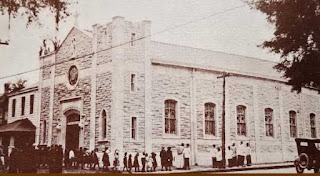 |
| The 'new' Blessed Trinity Church opened in 1922. It replaced a smaller, wooden church. |
We hear a lot today about the decline in volunteerism. It's always been somewhat of a struggle, though. Listen to this memoir about a 1937 meeting that occurred after morning Mass at Blessed Trinity Church in Ocala. The pastor asked for a woman to step up and lead a new altar society.
As Father Nixon went from lady to lady, they would decline saying they were too busy, or not well enough, or had small children. ...
Father Nixon was stymied. He had to leave Ocala to say Mass in mission territory and was in danger of being late. He was also still fasting, per the era's church rules about not eating past midnight the day before Mass. And September in Florida is hot, humid and summery. Air conditioning as we know it today didn't exist in the average home and business in 1937.
The priest finally turned toward 19-year-old Audrey Mortimer (later Audrey Mortimer Chambers) and appointed her president for a year. No one objected. Except Audrey, the writer of the memoir. She felt out of her league among the older women there. She'd only attended the meeting in place of her mother, who was ill. But Father Nixon was gone. He had just enough time to gulp some food at the rectory before racing to the mission church.
Audrey embraced her duties and gathered 22 women her own age to form the altar society. One of their duties was to cover the parish's candle bill. Money was tight during the Depression, so the young women staged rummage sales and card parties on weekends when they weren't working.
Today, parish maintenance is usually handled by professionals. Back then, members of altar societies literally cleaned the altars in church. They also polished brass, wiped down woodwork and cleaned wax bits from vigil lights.
One of the most difficult jobs, says Audrey in her memoir, was caring for the priestly vestments and the altar linens. She writes:
We did not have steam irons or air conditioning or even fans in those days, so you had to keep a towel handy to keep from sweating on the fresh linens.
The members had to create their own steam by ironing the heavy Irish linen altar cloths while still wet. Vestments with lace had to be ironed on a bath towel, also while still wet. (I just gave thanks for my modern appliances.)
Many early 20th century altar societies became part of the larger Council of Catholic Women organization, which formed on the national level in 1920. The Ocala group did exactly that, encouraged by Father Nixon. The altar society affiliated with the local diocesan CCW.
The connection brought the Ocala women into the orbit of CCWs throughout the diocese, station, region and nation. During a 1940 regional meeting, members heard a letter sent by then-Pope Pius XII in which he blessed their work.
The meeting's theme still resonates today. The world was troubled in 1940. In light of that, CCW members were urged to offer the best of religion and the best of citizenship. They were reminded to stay confident in God, to live their faith, do charitable work, support the parish's needs and "be prepared to meet the more serious times that were ahead."
That could have been written in 2023. My parish's CCW group this season raised and donated over $6,000 to local community initiatives. We gave to educational, medical, mission and family housing organizations. And yes, to specific parish needs. No, we're not chipping wax chips from the vigil lights. But we are bracing for serious times ahead.
Historical information in this post is from the book, "Catholics of Marion County," by Jane Quinn, published in 1978 by Mission Press, Ocala.

No comments:
Post a Comment